A set screw is a threaded fastener that normally does not have a head. Unlike most other threaded fasteners it is basically a compression device normally used to generate axial thrust. It is also known as grub screw. It is used to hold parts like sleeve, collar, coupling, gear etc. on a shaft to prevent relative motion. Various socket types are provided to allow the set screw to be rotated. These types include hexagon socket, fluted socket, screwdriver slot and square head. In this article information is given on selection of hexagon socket type set screws and their standards.
Point Selection According to Application
Point of a set screw is that part of the set screw which rotates against the shaft being secured. Point selection is normally determined by the nature of the application. Information on standard point types is as under.
Plain cup
The cup point is the most used style set screw. It is used for fast, permanent and semi-permanent location of parts on shafts with hardness differential of 10-15 Rockwell C points and where cutting in of cup edge on the shaft is acceptable. It is used for soft materials where high tightening torques are impractical.
Knurled cup
They are used for quick and permanent location of gears, collars, pulleys or knobs on shafts. They resist most severe vibration.
Flat
They are use where parts must be frequently re-set, as it causes little or no damage to part it bears against.
Cone
They are used for permanent location of parts. Deep penetration on tightening gives highest axial and holding power. In material over Rockwell C15 point is spotted to half its length to develop shear strength across point. It is also used for pivots and fine adjustment.
Dog
They are used for permanent location of one part to another. They have flat end with the threads stopping short of the end. The end is spotted in hole drilled in shaft or against flat (milled). They often replace dowel pins. Works well against hardened members or hollow tubing.
Oval
They have rounded end. They are used for frequent adjustment without deformation of part it bears against. They are also used for seating against an angular surface (applications where point meets shaft on an angle), circular U-grooves or axial V-grooves (splined). They are covered in ANSI standard.
Selection of Size
Socket set screws offer three types of holding power: torsional (resistance to rotation); axial (resistance to lateral movement); and vibrational. Size selection is an important factor in holding power. As a rule of thumb the screw diameter should be roughly 1/2 that of the shaft. Additional design considerations are as under.
Holding power is almost directly proportional to seating torque in a cup, flat, and oval point screws. Holding power can be increased by increasing seating torque. Greater holding power reduces the number of screws required and the assembled cost of the application. By its penetration, the set screw point can add as a much as 15% to total holding power. Cone points, with deepest penetration, give the greatest increase and oval points, with minimum penetration, the least. Making 1 the index for cup point, holding power values for others can be approximately assumed to be 1.07 for cone point, 0.92 for flat or dog points, and 0.90 for oval point.
Relative hardness between set screw and shaft is also a factor. A 10-point differential between the screw’s normal Rockwell C 50 and shaft should be maintained for full holding power. As much as 15% loss in holding power can result from a lower differential.
Vibration resistance can be achieved by correct size and proper tightening. The UNBRAKO knurl cup set screw offers additional mechanical locking resistance when required.
Product and dimensions standards
Product and dimensions standards used for socket set screws in various countries are as under.
ANSI: B 18.3, B 18.3.6M
IS: 1367 (part 5 and part 14, section 3), 6094
ISO: 4026 to 4029
DIN: 913 to 916
BS: 2470 and BS-EN ISO 4026 to 4029
| Type of Socket Set Screw | ISO Specification | DIN Specification |
|---|---|---|
| Flat Point | 4026 | 913 |
| Cone Point | 4027 | 914 |
| Dog Point | 4028 | 915 |
| Cup Point | 4029 | 916 |
Information on IS standard is given below.
IS 1367, part 5 specifies the mechanical properties and test methods made of carbon and alloy steel. The property classes are designated by the symbols shown in the table below.
| Designation of property classes in relation to Vickers hardness for set screws | ||||
|---|---|---|---|---|
| Property Class | 14H | 22H | 33H | 45H |
| Vickers Hardness, HV minimum | 140 | 220 | 330 | 450 |
The standard also give information on steel specification and mechanical properties and methods of testing. Limiting values for decarburization test and values of testing torque for various nominal sizes of screws for property class 45H are also given in the standard. The screw shall withstand the test torque given in the standard without splitting or cracking.
The threads shall be ISO metric, 6g as per IS 4218 (ISO 261) and IS 14962 (ISO 965).
Dimensions shall be as per IS 6094.
Most of the information in above article is given from Unbrako’s engineering guide. For ready reference, information on metric socket set screws made by Unbrako as per ANSI standard from their engineering guide is reproduced below.
Metric Socket Set Screws
NOTES:
- Material / Specifications: ASTM F912M / ANSI B 18.3.6M, ISO 4026 to 4029, DIN 913 to 916
- Hardness: Rockwell C45-53
- Angle: The cup angle is 135 maximum for screw lengths equal to or smaller than screw diameter. For longer lengths, the cup angle will be 124 maximum
- Threads: ANSI B 1.13M, ISO 261, ISO 262 (coarse series only)
- Thread Class: 4g 6g
- Grade: 45H
Dimensions and Recommended Seating Torque for Plain Cup Point and Knurled Cup Point Set Screws
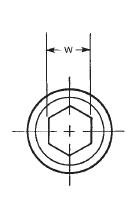 |
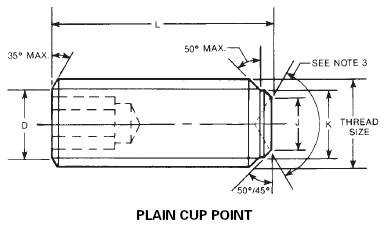 |
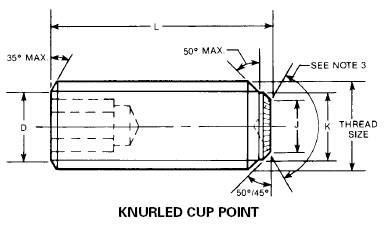 |
| Nom. thread size |
Pitch | D max. |
J max. | K max. |
L min. preferred | W nom. |
Recommended* seating torque |
|||
|---|---|---|---|---|---|---|---|---|---|---|
| Plain Cup | Knurled Cup | Plain Cup | Knurled Cup | N-m | in-lbs. | |||||
| MICRO SIZE – Plain Cup Only | ||||||||||
| M1.6 | 0.35 | 1.0 | 0.80 | – | – | 2.0 | – | 0.7 | 0.09 | 0.8 |
| M2 | 0.40 | 1.32 | 1.00 | – | – | 2.5 | – | 0.9 | 0.21 | 1.8 |
| M2.5 | 0.45 | 1.75 | 1.25 | – | – | 3.0 | – | 1.3 | 0.57 | 5.0 |
| STANDARD SIZE – Knurled Cup Point Supplied Unless Plain Cup Point Is Specified | ||||||||||
| M3 | 0.5 | 2.10 | 1.50 | 1.40 | 2.06 | 3.0 | 3.0 | 1.5 | 0.92 | 8.0 |
| M4 | 0.7 | 2.75 | 2.00 | 2.10 | 2.74 | 3.0 | 3.0 | 2.0 | 2.2 | 19.0 |
| M5 | 0.8 | 3.70 | 2.50 | 2.50 | 3.48 | 4.0 | 4.0 | 2.5 | 4.0 | 35.0 |
| M6 | 1.0 | 4.35 | 3.00 | 3.30 | 4.14 | 4.0 | 5.0 | 3.0 | 7.2 | 64 |
| M8 | 1.25 | 6.00 | 5.00 | 5.00 | 5.62 | 5.0 | 6.0 | 4.0 | 17.0 | 150 |
| M10 | 1.5 | 7.40 | 6.00 | 6.00 | 7.12 | 6.0 | 8.0 | 5.0 | 33.0 | 290 |
| M12 | 1.75 | 8.60 | 8.00 | 8.00 | 8.58 | 8.0 | 10.0 | 6.0 | 54.0 | 480 |
| M16 | 2.0 | 12.35 | 10.00 | 10.00 | 11.86 | 12.0 | 14.0 | 8.0 | 134 | 1190 |
| M20 | 2.5 | 16.00 | 14.00 | 14.00 | 14.83 | 16.0 | 18.0 | 10.0 | 237 | 2100 |
| M24 | 3.0 | 18.95 | 16.00 | 16.00 | 17.80 | 20.0 | 20.0 | 12.0 | 440 | 3860 |
| All dimensions in millimeters. *Not applicable to screws with a length equal to or less than the diameter. |
||||||||||
Dimensions for Flat Point, Cone Point and Dog Point Set Screws
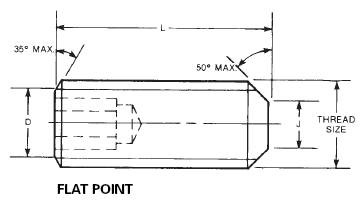 |
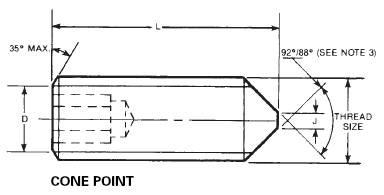 |
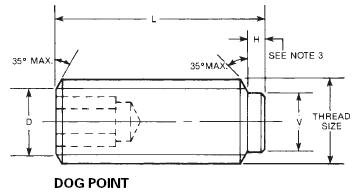 |
| Nom. thread size | Pitch | D Max. |
Flat Point | Cone Point | Dog Point | |||||
|---|---|---|---|---|---|---|---|---|---|---|
| J max. |
L min. preferred | J max. |
L min. preferred | H nom. | L min. preferred | V max. |
||||
| short length | long length | |||||||||
| M3 | 0.5 | 2.10 | 2.0 | 3.0 | 0.3 | 4.0 | 0.75 | 1.5 | 5.0 | 2.00 |
| M4 | 0.7 | 2.75 | 2.5 | 3.0 | 0.4 | 4.0 | 1.00 | 2.0 | 5.0 | 2.50 |
| M5 | 0.8 | 3.70 | 3.5 | 4.0 | 0.5 | 5.0 | 1.25 | 2.5 | 6.0 | 3.50 |
| M6 | 1.00 | 4.25 | 4.0 | 4.0 | 1.5 | 6.0 | 1.50 | 3.0 | 6.0 | 4.00 |
| M8 | 1.25 | 6.00 | 5.5 | 5.0 | 2.0 | 6.0 | 2.00 | 4.0 | 8.0 | 5.50 |
| M10 | 1.50 | 7.40 | 7.0 | 6.0 | 2.5 | 8.0 | 2.50 | 5.0 | 8.0 | 7.00 |
| M12 | 1.75 | 8.60 | 8.5 | 8.0 | 3.0 | 10.0 | 3.00 | 6.0 | 12.0 | 8.50 |
| M16 | 2.00 | 12.35 | 12.0 | 12.0 | 4.0 | 14.0 | 4.00 | 8.0 | 16.0 | 12.00 |
| M20 | 2.50 | 16.00 | 15.0 | 14.0 | 6.0 | 18.0 | 5.00 | 10.0 | 20.0 | 15.00 |
| M24 | 3.00 | 18.95 | 18.0 | 20.0 | 8.0 | 20.0 | 6.00 | 12.0 | 22.0 | 18.00 |
